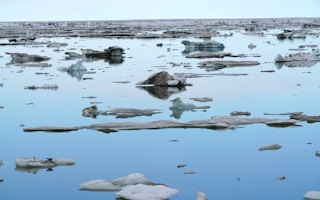A new reconstruction of the history of global temperatures for the last 12,000 years supports an argument often put forward by climate sceptics: that global climate is subject to natural cycles driven by astronomical forces and planet Earth might be in one, with human heating not responsible.
It is. But the latest finding offers no evidence for scepticism. For the last 6,500 years the global mean surface of the planet has slowly and naturally been getting cooler, as lower levels of summer sunlight hit the northern hemisphere.
And this gradual cooling came to a sudden end only in the 19th century as human cities and industries switched increasingly to coal, and then to oil and gas, to return ever-higher levels of ancient carbon to the atmosphere.
The rate of natural cooling would be imperceptible in any human lifespan: less than 0.1°C per thousand years.
This slow, subtle lowering of the temperature began 4,500 years before the beginning of the Christian era, in a Neolithic world of perhaps only 40 million people, at a time when Chinese villagers began to grow rice on terraces along the Yellow River and civilisation began to flourish in the Tigris-Euphrates valley.
“
This past decade was likely cooler than what the average temperatures will be for the rest of this century and beyond.
Nicholas McKay, associate professor, Northern Arizona University
This was a time when the first agricultural and pastoral settlements spread across Europe, along with the first pottery; when the Sahara was still grassland, and when most of Europe spoke just one language, now called Proto-Indo-European.
Researchers from the US and Europe report in the journal Scientific Data that they used the most comprehensive collection of palaeo-climatic evidence – 1,319 data sets based on tree rings, fossil pollen samples, ice cores and so on, collected from 679 sites worldwide – to establish that this must have been, for humans in prehistory, the moment of what they call “peak warmth.” From then on, the thermometer began to drop, at an average of 0.08C per millennium.
“The rate of cooling that followed the peak warmth was subtle, only around 0.01°C per 1,000 years. This cooling seems to be driven by slow cycles in the Earth’s orbit, which reduced the amount of summer sunlight in the Northern Hemisphere, culminating in the Little Ice Age of recent centuries,” said Michael Erb of Northern Arizona University.
More than a century of observation has shown that tiny cyclic changes in the Earth’s elliptical orbit can explain some of the patterns of climate change in the past, and confirm the lengths of the more recent Ice Ages, and the role of other planets in these periodic shifts.
Big picture unchanged
It is an article of faith among geologists that the present is key to the past, and the rocks and fossils preserve enduring evidence of the ups and downs of global temperatures.
It is now four years since European scientists proposed that climate change driven by greenhouse gas emissions from fossil fuels might have begun to delay the next Ice Age.
So the latest look at more recent data doesn’t change the big picture. In the last 100 or more years, global temperatures have risen by at least 1°C, and the average temperature of the last decade has been the warmest for 12,000 years, thanks to increasing concentrations of carbon dioxide in the atmosphere, as a consequence of human action.
“On the other hand, this past decade was likely cooler than what the average temperatures will be for the rest of this century and beyond, which are very likely to continue to exceed 1°C above pre-industrial temperatures,” said Nicholas McKay, one of the authors from Flagstaff, Arizona.
And his colleague Darrell Kaufman, who led the study, said: “It’s possible that the last time the sustained average global temperature was 1°C above the 19th century was prior to the last Ice Age, back around 125,000 years ago when sea level was around 20 feet (6 metres) higher than today.”
This story was published with permission from Climate News Network.








